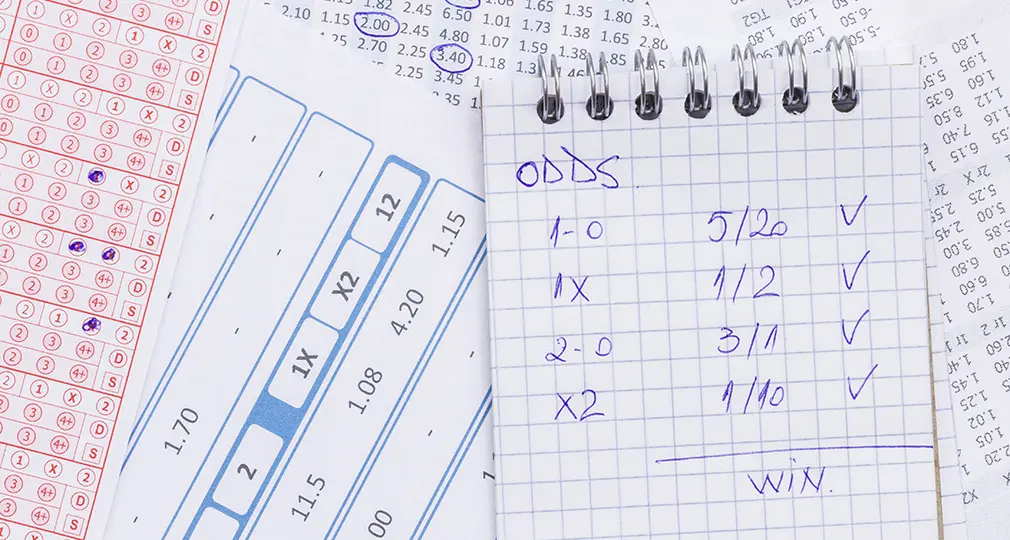Ready to understand how to read sports betting odds? If you’re new to this exciting world, figuring out the numbers can be a challenge. But we’re here to guide you through it all.
We will delve into various odds formats, encompassing decimals, fractions, and American odds, illustrating the step-by-step process of calculating potential payouts. We’ll also provide helpful hints for comparing and evaluating odds, such as comprehending implied probability, taking margins into account, looking into various bet kinds, keeping track of changes in odds, and using odds comparison websites. So let`s start!
Decoding Sports Betting Odds
Sports betting has become a well-liked form of entertainment and a possible source of income. However, learning the odds might be difficult. Odds act as a language that unveils the probability of a specific outcome and the potential payout linked to it. By deciphering these odds, bettors can make well-informed choices and enhance their prospects of achieving success.
A prevalent form of odds is decimal odds, extensively utilized in Europe and Australia. Presented in decimal format, these odds illustrate the complete payout a bettor would attain, encompassing the initial wager.
Another type that bookmakers use is fractional odds, which are frequently seen in the United Kingdom. The possible benefit in proportion to the initial bet is highlighted by this sort of odds.
In contrast, American odds are frequently seen in North America. These odds use positive and negative numbers to represent underdogs and favorites, respectively.
Beyond knowing the different odds formats, it’s important to know what implied probability is. The possibility of a result, as suggested by the odds, is known as implied probability. It is a way to convert odds into a percentage, allowing bettors to assess the probability implied by the odds.
Understanding Different Formats of Betting Odds
So, you’ve found yourself in the fascinating world of sports betting, and now you’re faced with all these numbers and weird symbols. So let’s break it down for you.
Let’s begin with decimal odds, which are rather simple. Imagine you see odds like 2.50. That implies that if your wager succeeds, you will receive a total payout of 2.50 units for every unit you staked. Simple, right? It includes your original wager, so you’re looking at your potential payout right then and there.

Now, let’s take a trip to the UK, where fractional odds reign supreme. You might come across something like 3/1. As a sports betting newcomer, you may ask how to read odds fractions. Well, here’s the deal: for every unit you bet, you stand to make a profit of three units if you win. But remember, the stake you placed is returned separately. So, if you bet $10 at 3/1 odds and win, you’ll get back $30 plus your first $10 stake.
Alright, let’s venture across the pond to America, where things work a little differently. As mentioned before, odds are displayed as both positive and negative numbers here. When you see positive odds like +200, therefore, if you bet $100 and win, you will receive a profit of $200. It’s like the sportsbook is giving you a little extra something for your successful bet. On the flip side, negative odds like -150 mean you have to bet $150 to win $100. Think of it as the sportsbook telling you that you have to put in a little more effort to reap the same reward.
And don`t forget about implied probability. By converting odds into percentages, you can compare them to your predictions. If you think there’s a higher chance of winning than what the odds imply, you might have stumbled upon a value bet. It’s like finding a hidden treasure!
Grasping the various formats of betting odds is essential for enjoying a fulfilling experience in the realm of sports betting. Take your time, familiarize yourself with the odds, and remember, it’s all about having fun and embracing the thrill of the game.
You can also find out even more in the video at the link.
How to Calculate Potential Payouts
With your sights set on a potential winning wager, your curiosity turns to determining the potential gains should fortune favor you. Fortunately, calculating potential payouts within sports betting odds is simpler than you might imagine. Let’s break it down step by step.
To begin, let’s delve into decimal odds. To ascertain your possible payout, all you need to do is multiply your betting amount by the decimal odds. For instance, if you wager $50 on a team with odds of 2.50, the multiplication of $50 by 2.50 results in a prospective payout of $125. This includes your initial wager of $50, so your profit would be $75 if your bet wins.

Moving forward, we will now advance to fractional odds. Keep in mind that fractional odds depict the potential profit in relation to your wager. Multiply your wager by the fraction and then add your original stake. For example, if you bet $20 on a team with odds of 3/1, multiply $20 by 3, which gives you $60. Add your initial stake of $20, and your potential payout would be $80 if your bet comes through.
Finally, let’s tackle American odds. These odds can be positive or negative, so the calculation depends on which type you’re dealing with.
The potential benefit is clear with positive odds. Your investment should be multiplied by the favorable odds after being divided by 100. Assume you placed a $100 wager on a team with +200 odds. Divide $100 by 100, which gives you 1. Multiply that by 200, and you get a potential profit of $200. Add your initial stake of $100, and your potential payout would be $300 if you win.
When it comes to negative odds, the calculation is a little different. To determine the necessary wager for a $100 win, divide 100 by the negative odds. For instance, if you see odds of -150, divide 100 by 150, which gives you approximately 0.67. Multiply that by your desired profit of $100, and you get around $67. So, to win $100 with odds of -150, it would be needed to bet around $67.
Keep in mind that these calculations are only approximations based on the provided chances. Check the precise regulations and conditions of the bookmaker you’re using because payout structures among sportsbooks might vary somewhat.
Tips for Comparing and Analyzing Betting Odds
Shop Around
Do not accept the first set of odds you are presented with. The odds for the same event might vary somewhat between sportsbooks and bookies. Spend some time comparing odds from several sources to choose the greatest deal. Even a small difference in odds can significantly impact your potential winnings.
Understand Implied Probability
As we have mentioned, implied probability is a key concept in sports betting. By converting odds into percentages, you can assess whether the implied probability aligns with your assessment. Look for discrepancies where the implied probability differs from what you believe to be the true probability. You may use this to find prospective value bets.

Consider the Margin
Sportsbooks make money by including a margin in their odds. The margin, often known as the “vig” or “juice,” is the bookmaker’s profit margin. When comparing odds, pay attention to the margin. Smaller margins generally indicate better value for bettors. Look for sportsbooks that offer lower margins, as this can lead to higher potential returns.
Consider Different Bet Types
Within the same event, various bet kinds may have varying betting odds. For instance, in a soccer game, the chances for a team to win by a wide margin and the chances for a particular individual to score a goal may differ. Examine several wager kinds and contrast the odds to spot situations when the bookmaker’s evaluation and yours may disagree.
Be Aware of Odds Movements
Betting odds are not set in stone. They can undergo alterations before an event due to a variety of factors like team updates, injuries, and shifts in market sentiment. Keep a watch on changes in the odds and learn why they occur. If you observe the odds moving one way or the other, it may be a sign of changing market sentiment or significant information that could affect the result.
Use Odds Comparison Websites
Take advantage of online resources such as odds comparison websites. These platforms compile odds from different sportsbooks, making it easier for you to compare and find the best value. These sites often provide additional features like historical odds data and odds movement graphs, which can be valuable tools in your analysis.
Case Study: Reading odds in a real-world scenario
Let’s delve into a real-world scenario for European sports betting enthusiasts, specifically the UEFA Champions League Final between Manchester City and Paris Saint-Germain (PSG). We’ll explore how to read sports score betting odds and interpret the odds in this context:
Sportsbook A:
Manchester City: 1.80
Paris Saint-Germain: 3.20
Draw: 3.50
Sportsbook B:
Manchester City: 4/5
Paris Saint-Germain: 11/5
Draw: 5/2
Here, we encounter decimal odds in Sportsbook A and fractional odds in Sportsbook B.

In Sportsbook A, Manchester City is listed at 1.80. If you place a €100 bet on Manchester City and they win, your total payout would be €180, including your initial stake. Paris Saint-Germain, on the other hand, has odds of 3.20, meaning a €100 bet on PSG would result in a potential payout of €320 if they emerge victorious. The odds of a draw are listed at 3.50, indicating a potential payout of €350 for a €100 wager.
Moving on to Sportsbook B, fractional odds are used. Manchester City is listed at 4/5, implying that for every €5 wagered, you could potentially win €4, resulting in a total payout of €9 (including the initial stake). Regarding Paris Saint-Germain, the odds stand at 11/5. This implies that for every €5 wagered, there’s the potential to secure €11 in winnings, leading to an overall payout of €16 (inclusive of the initial stake). As for a draw, the odds are 5/2, signifying that a €2.50 bet might lead to potential winnings of €5, resulting in a total payout of €7.50 (including the initial stake).
By comparing the odds, we can gather some insights. Both sportsbooks indicate that Manchester City is favored to win the match, as they have lower odds compared to PSG. However, there is a slight variance in the odds between the two books, underscoring the significance of exploring options to find the most favorable value.
It’s important to note that odds are not the sole determining factor in making a bet. Analyzing team form, player injuries, tactical considerations, and other relevant factors is crucial.
Conclusion: Mastering the Language of Sports Betting Odds
In conclusion, understanding how to read sports betting odds is a valuable skill for bettors. By deciphering diverse odds formats, such as decimal, fractional, and American, bettors can comprehend the probability of an outcome and the potential payout linked to it. Calculating potential payouts involves simple calculations based on the odds format.
Furthermore, the act of comparing and analyzing odds empowers bettors to recognize valuable opportunities and make well-informed betting choices. Considering factors such as implied probability, margins, odds movements, and different bet types further enhances the analysis. Utilizing odds comparison websites can assist in finding the best value across different sportsbooks. In the example of the UEFA Champions League Final case study, we saw how odds can vary between bookmakers. Remember, odds analysis should be complemented by comprehensive research and knowledge of the sport to form a robust betting strategy.












